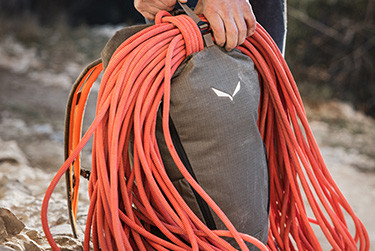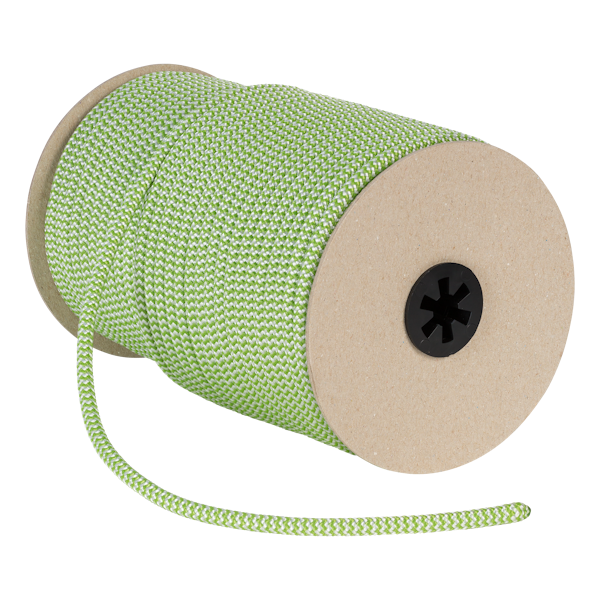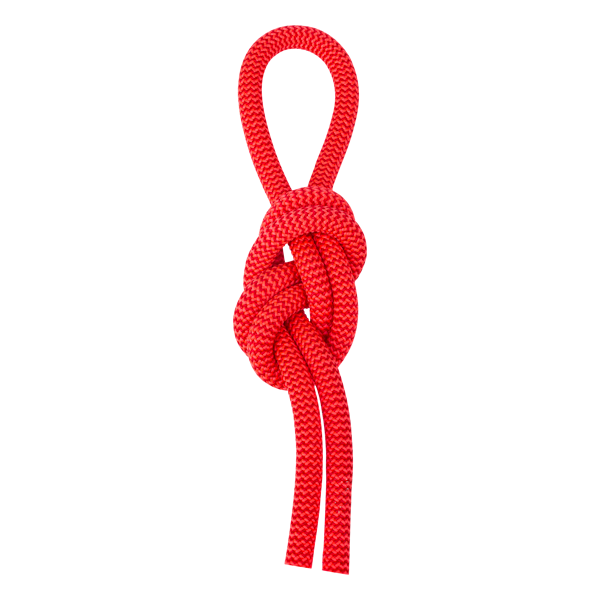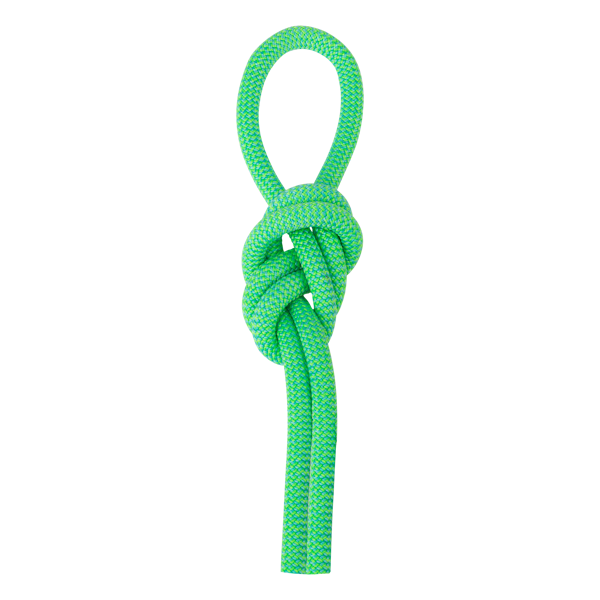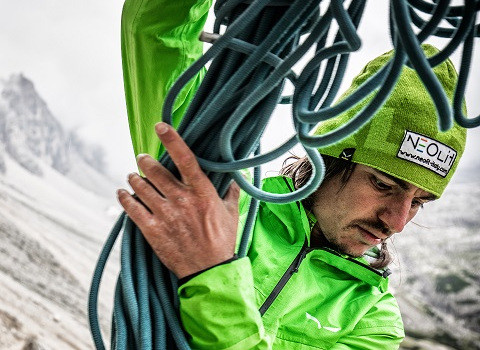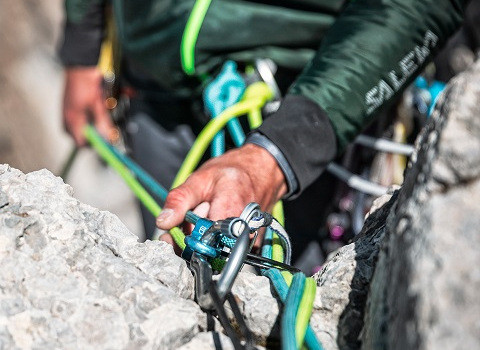expert advice / Climbing
HOW TO CHOOSE A CLIMBING ROPE
1. How to choose the right climbing or mountaineering rope?
When choosing a climbing rope there are five main considerations to take into account:
- Climbing rope type: Do you need a single, half, twin or static rope?
- Climbing rope length: How long does your rope need to be?
- Climbing rope diameter: How thick should your rope be?
- Special features: When do you need a treated rope? What about special markings
- Safety standards: What do all the norms and standards mean?
2. What type of rope do you use for climbing?
Climbing rope type:
There are three different types of dynamic climbing ropes.
Single ropes
- Single ropes are the most common type of climbing rope. The term ‘single’ refers to the fact that these rope are designed to be used on their own.
- Single ropes are for sport climbing, alpine climbing, trad climbing, mountaineering and big-wall climbing and top roping.
- Single ropes come in a range of different lengths and diameters that cover a range of different applications.
- Single ropes are labelled with a number 1 in a circle.
Half ropes
- Half ropes are best trad for climbing on zig-zagging routes, longer multi pitch routes, mountaineering and ice climbing.
- Half ropes, sometimes also called double ropes, are designed to be used as a pair.
- Climbing with half ropes involves using two ropes at the same time. One is clipped to protection on the left and the other to protection on the right. This lets rope run straight, reducing rope drag, especially where protection points are spread out.
- Unlike twin ropes, half ropes do not need to be clipped together into each bolt or piece of protection.
- Climbing with a pair of half ropes means you need a belay device that can manage two ropes at the same time.
- Half ropes are labelled with a ½ symbol in a circle.
Advantages:
- Half ropes can be used as a single rope to bring up a second. This is particularly relevant when climbing as a three. It means you can bring up two seconds.
- Climbing with two half ropes means that when abseiling, you can knot them together to rappel twice as far as you can with a single rope.
- Half-rope technique provides additional redundancy – in the event that one rope gets damaged by a sharp edge, rocks or ice.
Disadvantages:
- Using half ropes requires greater skill with rope management – both climbing and belaying.
- Climbing with two half ropes means that when abseiling, you can knot them together to rappel twice as far as you can with a single rope.
- Half ropes are designed and tested only for use as a matching pair.
Twin ropes
- Twin ropes are best for trad climbing on straight (i.e. not zig-zagging) multi-pitch rock routes, alpine climbing, mountaineering and ice climbing.
- Like half ropes, twin ropes are always used as a pair. However, with twin ropes, you clip both ropes through each bolt or piece of protection, just like you would with a single rope.
- Twin ropes generally have a lighter weight and a thinner diameter.
- Again like half rope technique, twin rope technique offers greater safety reserves due to increased redundancy afforded by using two ropes. Twin ropes are particularly suited to alpine climbing, ice and mixed climbing. And they also allow you to abseil twice as far as a single rope.
- Twin ropes are designed and tested only for use as a matching pair.
- Twin ropes are labelled with an infinity symbol (∞).
Some ropes have a triple certification, i.e. they are rated as single, half and twin ropes. This allows you to use them with all three climbing techniques. Remember though: it’s important to only use a rope for the purpose it was designed and tested to be used for.
Static ropes
- Static ropes have a substantially lower working elongation than dynamic ropes. In practice, this means they still stretch when loaded, but only by a very small amount.
- Static ropes are your go-to ropes for rescue work, climbing and descending fixed lines and hauling loads. They also excel in situations such as lowering an injured climber or building top rope anchors, where you don’t want rope stretch.
- Important: it’s not recommended to use a static rope for top roping and especially not for lead climbing. For sport climbing, dynamic elongation, i.e. rope stretch, is an important safety factor.
1. How to choose the right climbing rope?
2. What type of rope do you use for climbing?
3. How do I know what size climbing rope to buy?
4. What features should I look for when comparing climbing ropes?
3. How do I know what size climbing rope to buy?
Climbing rope length
How long does your rope need to be?
Dynamic climbing ropes: range in length from 30 metres to 80 metres. For outdoor climbing, 50 metres or 60 metres is standard.
- Climbing gyms: Generally speaking, you can use a shorter rope, of say 35 metres. Make sure your rope is long enough to lower your partner all the way back down to the ground. If you’re not sure, check with the gym before you buy.
- Outdoor climbing: Check the online topos or guidebooks before you go to know how high the crags are where you plan to climb.
Your rope will need to be long enough so that it’s twice the length or more than your chosen route or pitch, unless you plan to walk off the top that is.
Take for example, a straight route on a 30-metre cliff. Here you would need at least 60 metres of rope to be able to climb up and get back down from an anchor at the top.
Modern sport-climbing routes sometimes require longer ropes. Again, check the guidebooks or ask other climbers before you go.
Static ropes: come in a variety of lengths and are often sold by the metre.
Note: Using a long rope to frequently climb short routes, for example at the gym, is not good for your rope. Buy the right length of rope for the climbing you are doing. You might find you need different lengths for different scenarios.
Climbing rope diameter
When choosing a rope, diameter is an important factor. Different diameters are more suited to different types of climbing. Generally speaking, the thinner, or skinnier your rope, the lighter it will be.
Skinny ropes require extra caution when belaying and abseiling. They are not suitable for beginners. Make sure, your belay device is appropriate for the diameter of rope you are using and that your belayer is both experienced and attentive.
Due to their thinner diameter, skinnier ropes are often less robust and have a shorter lifespan. This means they should not be used for regular top-roping or repeated falls when working routes. In addition, skinny ropes are not rated to hold as many falls as thicker ropes.
Thicker-diameter ropes are normally more abrasion-resistant and stand up better to frequent use. For top roping at the local crag, you’ll be better off with a thicker rope. For alpine multi-pitch routes with long walk-ins and descent, look for skinnier, lighter ropes.
Single ropes
Single ropes range in diameter from 8.5 mm to 10.5 mm.
For all-around use we recommend single ropes in the 9.5 - 9.9 mm range. This diameter is light enough to pack for the mountains or your local crag, yet durable enough for top-roping.
For gym climbing and extensive top roping, we recommend using ropes with a thicker diameter single rope, say 10 mm, as they are more durable.
Thicker-diameter single ropes are generally stronger and can withstand a greater number of falls. The downside is that they weigh more.
- Half ropes
Half ropes come in diameters from 7.5 to 9 mm. - Twin ropes
Twin ropes normally have a diameter of 7 to 8 mm. - Static ropes
Static ropes generally come in diameters from 9 to 13 mm.
RELATED PRODUCTS
Related Topics
WHAT CLIMBING GEAR DO YOU NEED?
Climbing covers a whole load of different disciplines, all with their specific types of gear, techniques and training.
MOUNTAINEERING SKILLS & TECHNIQUES NEEDED
The essential technical skills needed for mountaineering take some time to learn.
HOW TO LEARN ALPINE CLIMBING
Alpine climbing means mountain climbing in high, often glaciated areas that can include scrambling and technical climbing in snow, rock or mixed terrain.
4. What features should I look for when comparing climbing ropes?
Climbing rope special features
Finishing treatments
Some manufacturers give their ropes special impregnation finishing treatments to extend their lifespan, improve handling and flexibility or prevent them from absorbing water.
Dry Treatment:
Untreated ropes can absorb water. This can make them heavy and difficult to handle. In winter, they may even freeze and go stiff in cold conditions, making it impossible for them to run through a belay device. In addition, if a rope gets heavy then it’s less able to withstand the forces generated in a fall.
Dry treatment ropes do not absorb as much water. They are definitely a better option for ice climbing, mixed climbing, mountaineering and multi-pitch trad climbing, where you are likely to encounter rain, snow or ice. Dry-treated ropes do cost more though. For sport climbing, where you are unlikely to climb in the wet, they’re not really necessary. See also Water absorption.
Rope markings
It’s very useful to have an easily-identifiable middle marking on your rope. This is essential when abseiling. It’s also very useful when estimating how much rope a leader may have left. Some ropes also come with end warning marks for the same reason. They also let you know that you’re coming to the end of the rope when abseiling or lowering a climber.
The middle marking is often in a special black dye. Some manufacturers use special different sheath patterns to give their ropes a permanent middle marking.
Important: If you decide to cut a length off your rope for any reason, make sure you re-measure the middle marking to prevent accidents.
5. Climbing rope safety norms and standards
UIAA – The International Climbing and Mountaineering Federation (Union Internationale des Associations d’Alpinisme) is the leading developer of global standards for climbing and mountaineering equipment.
EN – EN stands for European Norm. This is an agreed-safety standard for specific products. For dynamic climbing ropes this standard is indicated by the standard EN 892.
CE – CE certification is required by the European Commission that establishes safety standards.
The labelling on dynamic climbing ropes lists the test results for UIAA safety standards:
Number of Falls
This rating given on rope labels tells you the number of falls a sample of this rope took before this rope broke in the simulated fall drop test.
Static Elongation – This measures how much the rope stretches when weighted without a fall. Single ropes must not stretch more than 10% and half ropes more than 12%.
Dynamic Elongation - Dynamic elongation is the distance the rope stretches during the first standard UIAA drop test fall. The dynamic elongation of a rope reflects its ability to withstand impact force. This is one of the main factors that makes a rope ‘dynamic’. In practice, stretch reduces the impact force of a fall, which can mean it reduces the force placed on a bolt or a piece of trad protection. This is why dynamic climbing ropes are much safer for climbing.
Sheath Slippage – This has a direct impact on the handling characteristics of a rope. Basically, less sheath slippage means a better performing rope.
Sheath Proportion – Normal ropes have a sheath to core ratio of 35-45 %. For intensive use, such as working routes or top-roping, there are ropes with a higher sheath proportion.
Water absorption
The UIAA water-repellent dry test is a standard and test developed by the UIAA to measure the water repellency of ropes or the amount of water absorbed (expressed as a percentage of the ropes weight).
The following compulsory information is supplied on a rope’s labelling:
- Manufacturer/trading name
- Year manufactured
- Length specification
- Type of rope/diameter
- Symbol for: single rope/ half rope/ twin rope
- CE mark with 4-digit identification number
The year of manufacture is particularly important here as ropes deteriorate even when they are not used and should be replaced according to the manufacturer’s instructions and at the very latest after ten years. This is because synthetic fibres deteriorate over time.
Remember: You are responsible for your own safety. If you’re new to climbing, learn the ropes by getting some instruction.


